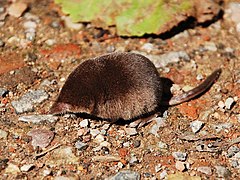Ryjówki
podrodzina ssaków
Ryjówki[2] (Soricinae) – podrodzina ssaków z rodziny ryjówkowatych (Soricidae).
| Soricinae | |||
| G. Fischer, 1814[1] | |||
 Przedstawiciel podrodziny – ryjówka malutka (Sorex minutus) | |||
| Systematyka | |||
| Domena | |||
|---|---|---|---|
| Królestwo | |||
| Typ | |||
| Podtyp | |||
| Gromada | |||
| Podgromada | |||
| Infragromada | |||
| Rząd | |||
| Podrząd | |||
| Rodzina | |||
| Podrodzina |
ryjówki | ||
| Typ nomenklatoryczny | |||
|
Sorex Linnaeus, 1758 | |||
| Plemiona | |||
| |||
Występowanie
edytujPodrodzina obejmuje gatunki występujące w Eurazji i Ameryce[3][4].
Podział systematyczny
edytujDo podrodziny należą następujące występujące współcześnie plemiona[5][3][2]:
- Soricini G. Fischer, 1814 – ryjówki
- Blarinini Kretzoi, 1965 – blariny
- Blarinellini Reumer, 1998 – blarynki
- Anourosoricini J. Anderson, 1879 – krecikówki
- Notiosoricini Reumer, 1984 – sorki
- Nectogalini J. Anderson, 1879 – wodoryjki
Opisano również plemię wymarłe[6]:
- Beremendiini Gureev, 1971
Rodzaje wymarłe nie należące do żadnego z ww. plemion[6]:
- Adeloblarina Repenning, 1967[7] – jedynym przedstawicielem był Adeloblarina berklandi Repenning, 1967
- Antesorex Repenning, 1967[8]
- Arctisorex Hutchison & Harington, 2002[9] – jedynym przedstawicielem był Arctisorex polaris Hutchison & Harington, 2002
- Builstynia Ziegler, Dahlmann & Storch, 2007[10] – jedynym przedstawicielem był Builstynia fontana Ziegler, Dahlmann & Storch, 2007
- Dimylosorex Rabeder, 1972[11]
- Hesperosorex Hibbard, 1958[12] – jedynym przedstawicielem był Hesperosorex lovei Hibbard, 1958
- Macroneomys Fejfar, 1966[13] – jedynym przedstawicielem był Macroneomys brachygnathus Fejfar, 1966
- Mafia Reumer, 1985[14]
- Paenesorex Ziegler, 2003[15] – jedynym przedstawicielem był Paenesorex bicuspis Ziegler, 2003
- Paracryptotis Hibbard, 1950[16]
- Paranotiosorex Mou Yun, 2011[17] – jedynym przedstawicielem był Paranotiosorex panacaensis Mou Yun, 2011
- Parasoriculus Qiu Zhuding & Storch, 2000[18] – jedynym przedstawicielem był Parasoriculus tongi Qiu Zhuding & Storch, 2000
- Shikamainosorex Hasegawa, 1957[19] – jedynym przedstawicielem był Shikamainosorex densicingulatus Hasegawa, 1957
- Sulimskia Reumer, 1984[20]
- Tregosorex Hibbard & Jammot, 1971[21] – jedynym przedstawicielem był Tregosorex holmani Hibbard & Jammot, 1971
- Zelceina Sulimski, 1962[22]
Przypisy
edytuj- ↑ J.G. Fischer von Waldheim: Zoognosia tabulis synopticis illustrata, in usum praelectionum Academiae imperialis medico-chirugicae mosquensis edita. Cz. 3. Mosquae: Nicolai S. Vsevolozsky, 1814, s. x. (łac.).
- ↑ a b Nazwy zwyczajowe za: W. Cichocki, A. Ważna, J. Cichocki, E. Rajska-Jurgiel, A. Jasiński & W. Bogdanowicz: Polskie nazewnictwo ssaków świata. Warszawa: Muzeum i Instytut Zoologii PAN, 2015, s. 69–75. ISBN 978-83-88147-15-9. (pol. • ang.).
- ↑ a b C.J. Burgin, D.E. Wilson, R.A. Mittermeier, A.B. Rylands, T.E. Lacher & W. Sechrest: Illustrated Checklist of the Mammals of the World. Cz. 2: Eulipotyphla to Carnivora. Barcelona: Lynx Edicions, 2020, s. 22–46. ISBN 978-84-16728-35-0. (ang.).
- ↑ D.E. Wilson & D.M. Reeder (red. red.): Subfamily Soricinae. [w:] Mammal Species of the World. A Taxonomic and Geographic Reference (Wyd. 3) [on-line]. Johns Hopkins University Press, 2005. [dostęp 2020-12-31].
- ↑ N. Upham, C. Burgin, J. Widness, M. Becker, C. Parker, S. Liphardt, I. Rochon & D. Huckaby: Treeview of Mammalian Taxonomy Hierarchy. [w:] ASM Mammal Diversity Database (Version 1.11) [on-line]. American Society of Mammalogists. [dostęp 2023-10-23]. (ang.).
- ↑ a b J.S. Zijlstra, Soricinae Fischer, 1814, Hesperomys project (Version 23.8.1), DOI: 10.5281/zenodo.7654755 [dostęp 2023-10-23] (ang.).
- ↑ Repenning 1967 ↓, s. 37.
- ↑ Repenning 1967 ↓, s. 30.
- ↑ J.H. Hutchison & C.R. Harington. A peculiar new fossil shrew (Lipotyphla, Soricidae) from the High Arctic of Canada. „Canadian Journal of Earth Sciences”. 39 (4), s. 440, 2002. DOI: 10.1139/E01-078. (ang.).
- ↑ R. Ziegler, T. Dahlmann & G. Storch. Marsupialia, Erinaceomorpha and Soricomorpha (Mammalia). „Annalen des Naturhistorischen Museums in Wien”. 108A, s. 138, 2007. JSTOR: 41702096. (ang.).
- ↑ G. Rabeder. Ein neuer Soricide (Insectivora) aus dem Alt-Pleistozän von Deutsch-Altenburg 2 (Niederösterreich). „Neues Jahrbuch für Geologie und Paläontologie. Monatshefte”. Jahrgang 1972, s. 636, 1972. (niem.).
- ↑ C.W. Hibbard. Notes on Late Cenozoic shrews. „Transactions of the Kansas Academy of Science”. 60 (4), s. 328, 1958. DOI: 10.2307/3626384. (ang.).
- ↑ O. Fejfar. Über zwei neue Säugetiere aus dem Altpleistozän von Böhmen. „Neues Jahrbuch für Geologie und Paläontologie. Monatshefte”. 11, s. 685, 1966. (niem.).
- ↑ Reumer 1985 ↓, s. 78.
- ↑ R. Ziegler. Shrews (Soricidae, Mammalia) from Middle Miocene karstic fissure fill sites of Petersbuch near Eichstätt, Southern Franconian Alb (Bavaria). „Paläontologische Zeitschrift”. 77 (2), s. 312, 2003. DOI: 10.1007/BF03006944. (ang.).
- ↑ C.W. Hibbard. Mammals of the Rexroad Formation from Fox Canyon, Kansas. „Contributions from the Museum of Paleontology, University of Michigan”. 8 (6), s. 121, 1950. (ang.).
- ↑ Y. Mou. Shrews, lagomorphs, and rodents (excluding Cricetidae) from the Pliocene Panace Formation, southeastern Nevada, USA. „Palaeontologia Electronica”. 14 (3; 32A), s. 4, 2011. (ang.).
- ↑ Z.-d. Qiu & G. Storch. The early Pliocene micromammalian fauna of Bilike, Inner Mongolia, China (Mammalia: Lipotyphla, Chiroptera, Rodentia, Lagomorpha). „Senckenbergiana lethaea”. 80 (1), s. 180, 2000. DOI: 10.1007/BF03043669. (ang.).
- ↑ Y. Hasegawa. On a new Insectivora from the Upper Kuzuü Formation in Japan. „Scientific Reports of Yokohama National University”. 6, s. 65, 1957. (ang.).
- ↑ Reumer 1985 ↓, s. 86.
- ↑ C.W. Hibbard & D. Jammot. The shrews of the WaKeeney local fauna, Lower Pliocene of Trego County, Kansas. „Contributions from the Museum of Paleontology, University of Michigan”. 23 (24), s. 377, 1971. (ang.).
- ↑ A. Sulimski. Supplementary studies on the insectivores from Wȩẓe 1 (Poland). „Acta Palaeontologica Polonica”. 7 (3–4), s. 476, 1962. (ang.).
Bibliografia
edytuj- Ch.A. Repenning. Subfamilies and genera of the Soricidae. „United States Geological Survey Professional Paper”. 565, s. 1–74, 1967. (ang.).
- J.W. Reumer. Ruscinian and early Pleistocene Soricidae (Insectivora, Mammalia) from Tegelen (The Netherlands) and Hungary. „Scripta Geologica”. 73, s. 1–173, 1985. (ang.).